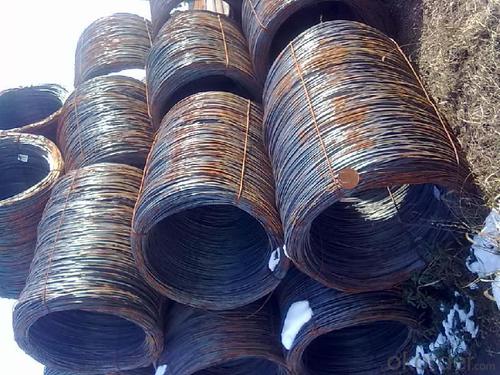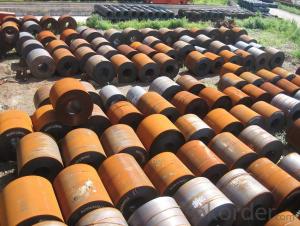hot rolled wire rod for construction GB Q235
- Loading Port:
- Tianjin
- Payment Terms:
- TT OR LC
- Min Order Qty:
- 25 m.t.
- Supply Capability:
- 100000 m.t./month
OKorder Service Pledge
OKorder Financial Service
You Might Also Like
Product Description:
Specifications of Hot Rolled Wire Rod:
Steel Grade: Q195/235, SAE1006-1018B Standard: ASTM, GB
Diameter: 5.5mm, 6.5mm, 7mm,8mm,9mm,10mm,12mm,14mm
Type: in coil, coil weight around 2MT Alloy or Not: Alloy
Technique: Hot Rolled Place of Origin: China Mainland
Surface: round, no twisted, light and smooth Brand Name: HSKY
Chemical Composition: (Please kindly find our chemistry of our material based on Q195、Q235A and Q235B as below for your information)
| Trademark | Rank | Chemical composition (quality score) % | ||||
| C | Si | Mn | S | P | ||
| ≤ | ≤ | ≤ | ||||
| Q195 | 0.06-0.12 | 0.30 | 0.25 | 0.050 | 0.045 | |
| Q235 | A | 0.14-0.22 | 0.30 | 0.30-0.65 | 0.050 | 0.045 |
| Q235 | B | 0.12-0.20 | 0.30 | 0.30-0.70 | 0.045 | 0.045 |
Usage and Applications of Hot Rolled Wire Rod:
After hot-rolled the products shaped into coil and delivery as finished product, including round, square, rectangular, hexagonal and so on. Since most of the products are round, it is generally called wire rod. Carbon steel wire rod is widely used in construction and manufacturing. Carbon steel wire rod is mainly used for reinforcement of reinforced concrete and welded structure or reprocessed (roberts , nail, etc.) materials, especially used to produce wire drawing, welding electrode, nails, spring, electronic, precise machinery parts and so on.
Packaging & Delivery of Hot Rolled Wire Rod:
Packaging Detail: products are packed in coil, each coil weight around 2 MT, and then shipped by container or bulk vessel
Delivery Detail: within 45 days after received deposit or LC.
Label: to be specified by customer, generally, each bundle has 1-2 labels
Trade terms: FOB, CFR, CIF
Hot Rolled Wire Rod in Container



Note:
1. Our products are produced according to national standard (GB), if not, supply according to national standards (GB) or agreement as customer required.
2. Other Grade and Standard carbon steel wire rod we can supply:
Grade: H08A, 30MnSi, 62B-82B
Standard: AISI, BS, JIS, DIN
The Minimum Order Quantity of these products is high, and need to be confirmed.
3. We can not only supply carbon steel wire rod; if you need anything about building materials, please contact us.
4. Please send us your detail specifications when inquire. We will reply to you as soon as possible. We sincerely hope we can establish a long stable business relationship
- Q: How is steel wire rod used in the production of wire mesh for automotive filters?
- Steel wire rod is crucial in making wire mesh for automotive filters. It is processed in a steel mill, where it is heated and rolled into thin wires of the same thickness. This ensures that the wire is strong and flexible, making it suitable for use in different automotive applications. Once the wire rod is turned into wires, it goes through additional processing to create the wire mesh. This involves weaving the wires together in a specific pattern using a specialized machine. The weaving process forms a mesh structure that allows air or fluids to pass through while filtering out impurities. The wire mesh made from steel wire rod is then cut and shaped to fit the specific needs of automotive filters. It is commonly used in air filters, oil filters, and fuel filters, among others. The wire mesh provides a sturdy framework that effectively captures and retains contaminants, preventing them from entering the engine or other crucial systems. Additionally, the use of steel wire rod ensures that the wire mesh can withstand corrosion, high temperatures, and mechanical stress, which are common challenges in automotive applications. This makes it an ideal choice for automotive filters, as they operate in harsh and demanding conditions. In conclusion, steel wire rod is essential for producing wire mesh for automotive filters. It serves as the raw material, offering strength, flexibility, and durability. The wire mesh, in turn, efficiently filters out impurities and protects the integrity of automotive systems.
- Q: How is steel wire rod used in the manufacturing of staples?
- Staples manufacturing heavily relies on steel wire rods, which are indispensable components. These wire rods are typically made from top-notch steel and are available in a range of diameters. The staple manufacturing process initiates by coiling the steel wire rods and then drawing them through a set of dies to reduce their diameter and increase their length. This drawing process not only enhances the wire's strength but also ensures its uniformity. Once the desired wire diameter is achieved, the steel wire is cut into smaller lengths, determining the size of the produced staples. These wire lengths are then introduced into a specialized staple manufacturing machine, where they undergo a series of operations. To begin with, the wire is fed into a machine that straightens and cleans it, eliminating any impurities or irregularities. Afterward, the straightened wire is cut and shaped into individual staple blanks. These blanks undergo further processing through a combination of bending, cutting, and shaping operations to form the characteristic "U" shape of the staple legs. Following that, the legs of the staples are bent inward or clinched to create the necessary tension for securely holding papers or other materials together. Typically, this process is executed using a clinching machine, which exerts the required force to bend the legs inward and create the final staple shape. Lastly, the manufactured staples go through a rigorous quality control check to ensure compliance with the required standards in terms of dimensions, strength, and overall quality. This evaluation may include checking for proper leg length, shape uniformity, and testing the staples' ability to securely hold materials. In essence, steel wire rods play a pivotal role in the staple manufacturing process, providing high-strength material necessary for securely fastening papers or other materials. Through a series of intricate processes, the wire rods are transformed into the iconic "U" shape of staples, guaranteeing their functionality and dependability for various applications.
- Q: How is steel wire rod used in the manufacturing of wire for electrical cables?
- Steel wire rod is an essential raw material in the manufacturing of wire for electrical cables. The wire rod is first drawn through a series of dies to reduce its diameter and increase its length, resulting in a fine wire. This wire is then insulated with a non-conductive material, such as PVC or rubber, to create the electrical cable. The steel wire rod provides the necessary strength and conductivity to the wire, making it suitable for electrical applications.
- Q: How is steel wire rod used in the production of wire displays?
- Steel wire rod is used in the production of wire displays as it serves as the foundation material for creating the wire frames and structures that make up the displays. The wire rod is first processed and shaped into the desired dimensions and then formed into different shapes and configurations to create the structures that hold and showcase products in wire displays.
- Q: What are the different applications of stainless steel wire rod?
- Stainless steel wire rods have a wide range of applications across various industries. They are commonly used in the manufacturing of wire products such as springs, cables, ropes, mesh, and welding electrodes. Additionally, stainless steel wire rods find utility in the construction sector for reinforcing concrete structures and in the automotive industry for manufacturing parts like exhaust systems and fasteners. These wire rods are also utilized in the production of kitchenware, surgical instruments, and electrical appliances due to their corrosion resistance, strength, and aesthetic appeal.
- Q: How is steel wire rod used in the production of wire mesh for agricultural applications?
- Steel wire rods are used in the production of wire mesh for agricultural applications by being drawn through a series of dies to reduce their diameter, resulting in wire of the desired thickness. This wire is then woven or welded together to form a mesh, which is used for various agricultural purposes such as securing fences, creating cages for livestock, and constructing trellises for plants. The strength and durability of steel wire rods make them ideal for withstanding the harsh conditions and heavy loads often encountered in agricultural settings.
- Q: How are steel wire rods used in the production of wire springs?
- Wire springs rely heavily on steel wire rods, which are melted and shaped into cylindrical forms through rolling. The resulting rods are then drawn through dies to decrease their diameter and increase their length, imparting strength and flexibility. This process ensures the suitability of the wire rods for spring usage. After the drawing process, the steel wire rods are commonly coiled onto large spools or reels. These coiled wires are then fed into machines that manufacture springs. The wire is cut to the desired length and shaped into different spring forms, such as helical coils or conical shapes. The inherent strength and elasticity of steel wire rods make them highly suitable for wire springs. These springs find extensive applications in various industries, including automotive suspensions, furniture, industrial machinery, and household appliances. The steel wire rods provide the necessary tensile strength and resilience to endure the forces and stresses experienced in these applications. To sum up, steel wire rods play a crucial role in the production of wire springs, providing the strength, flexibility, and resilience required for effective functioning in diverse industries and applications.
- Q: How is steel wire rod used in the manufacturing of wire for heating elements?
- Steel wire rod is used in the manufacturing of wire for heating elements by being processed through various stages of drawing, annealing, and coating. The wire rod is initially drawn down to the desired wire diameter, ensuring the required tensile strength and conductivity. It is then annealed to relieve any internal stresses and increase flexibility. Finally, a protective coating may be applied to enhance durability and resistance to corrosion. The resulting wire is then utilized in the fabrication of heating elements, which find applications in various heating devices such as ovens, toasters, and electric heaters.
- Q: How are steel wire rods used in the production of welding electrodes?
- Steel wire rods are used in the production of welding electrodes as they serve as the core material for the electrode. The steel wire rods are manufactured with specific chemical composition and mechanical properties to ensure strength and durability. They are then further processed to form the electrode's outer coating, which provides additional properties such as arc stability, slag removal, and alloying elements. Overall, steel wire rods are essential for the production of welding electrodes as they form the backbone of the electrode, enabling efficient and effective welding operations.
- Q: What are the different types of steel wire rod surface defect monitoring and reporting tools?
- Some of the different types of steel wire rod surface defect monitoring and reporting tools include visual inspection tools, such as magnifying glasses and microscopes, automated inspection systems, like laser scanners and cameras, and specialized software for analyzing and reporting defects.
Send your message to us
hot rolled wire rod for construction GB Q235
- Loading Port:
- Tianjin
- Payment Terms:
- TT OR LC
- Min Order Qty:
- 25 m.t.
- Supply Capability:
- 100000 m.t./month
OKorder Service Pledge
OKorder Financial Service
Similar products
Hot products
Hot Searches
Related keywords




























